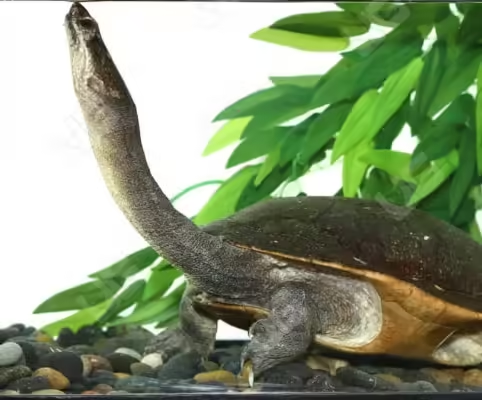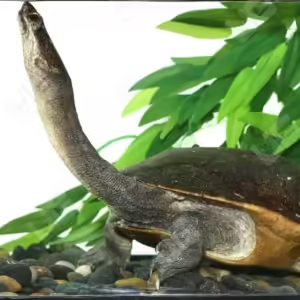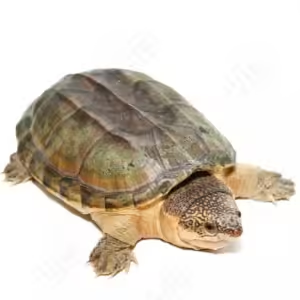Northern Snake Neck Turtle For Sale
$324.99
WE HAVE ADULT NORTHERN SNAKE NECK TURTLE FOR SALE. HERE ARE SOME HIGHLIGHTS:
- Chelodina Rugosa
- Field Collected
- Approximately 7 – 10 Inches In Shell Length
- Adults Can Grow Up To 10 – 14 Inches In Shell Length
- Fascinating To Watch Swim & Feed On Blood Worms, Silversides, Turtle Pellets, And Shrimp
FUN FACTS!
- Amazing Creatures Displaying Long Pale Necks Able To Reach The Waters Surface
- Native To Northern Australia And Southern New Guinea
- They Can Be Found In Fresh water Hiding Between Rocks And Under Logs. Often Burying Themselves In The Mud.
- These Are Beautiful Turtles That Have Stunning Color On Its Body, Combined With Unique Patterns On Its Shell, That Are Coming To You With A Smile
Northern Snake Neck Turtle
The Northern Snake Neck Turtle, scientifically known as Chelodina rugosa, is a remarkable species that captivates with its unique physical attributes. One of the most striking features of this turtle is its elongated neck, which can be nearly as long as its shell. This distinctive neck has earned the species its common name and sets it apart from other turtles. The shell of the Northern Snake Neck Turtle is another notable characteristic, exhibiting a smooth, streamlined appearance that aids in its aquatic lifestyle.
In terms of geographical distribution, the Northern Snake Neck Turtle predominantly inhabits regions of Northern Australia and New Guinea. These areas provide the ideal environment for the species, offering a mix of freshwater rivers, billabongs, and swamps. The turtle’s natural habitat is often characterized by slow-moving or still waters, where it can easily navigate and forage for food. Its diet is quite diverse, ranging from small fish and aquatic invertebrates to plant matter, showcasing its adaptability to different ecological conditions.
Understanding the habitat and physical characteristics of the Northern Snake Neck Turtle is crucial for conservation efforts. The regions it inhabits are subject to environmental changes, which can impact the species’ survival. Conservationists emphasize the importance of preserving these natural habitats to ensure the continued existence of this enigmatic turtle. By studying its unique physical traits and preferred environments, researchers can develop more effective strategies to protect and sustain the Northern Snake Neck Turtle populations.
Physical Characteristics and Adaptations
The Northern Snake Neck Turtle, scientifically known as Chelodina rugosa, exhibits a range of intriguing physical characteristics that contribute to its enigmatic appearance and survival. This species is easily identified by its elongated neck, which can often be as long as its carapace. Adults typically measure between 20 to 30 centimeters in shell length, with females generally being larger than males. The turtle’s neck, unlike those of typical turtles, does not retract directly back into the shell but instead folds sideways beneath the shell’s edge.
The carapace of the Northern Snake Neck Turtle is usually dark brown or olive, offering effective camouflage in its natural habitat. This coloration helps the turtle blend seamlessly into the muddy waters and vegetated areas it frequents. The plastron, or the underside of the shell, is usually lighter, ranging from cream to yellowish hues, which can serve as a deterrent to predators when viewed from below.
A distinctive feature of the Northern Snake Neck Turtle is its long, flexible neck, which is instrumental in its hunting strategy. This anatomical adaptation allows the turtle to employ a rapid strike mechanism to capture prey. By swiftly extending its neck, it can snatch fish, insects, and amphibians with remarkable precision. Additionally, the lateral folding of the neck enables the turtle to protect its vulnerable head and neck from potential threats by tucking them securely within the shell’s protective confines.
The shell itself is robust and slightly flattened, which aids in streamlining the turtle’s movement through water, facilitating both swimming and burrowing into soft substrates. The marginal scutes, or the outer edge of the shell, are often serrated in juveniles, providing extra protection and aiding in camouflage. As the turtle matures, these serrations tend to smooth out.
These physical adaptations collectively enhance the Northern Snake Neck Turtle’s ability to survive and thrive in its aquatic environment. The combination of an elongated neck for effective predation, protective shell for defense, and camouflaging coloration ensures that this species remains a formidable inhabitant of its ecosystem.
Habitat and Ecosystem
The Northern Snake Neck Turtle, scientifically known as Chelodina rugosa, primarily inhabits slow-moving rivers, swamps, and wetlands. These environments provide the essential conditions for their survival, such as abundant aquatic vegetation, muddy substrates, and ample hiding spots. The presence of these turtles in such habitats is indicative of healthy, biodiverse ecosystems.
These turtles are highly adaptable to various environmental conditions, thriving in both permanent and temporary water bodies. During the dry season, they exhibit remarkable behavior by burrowing into the mud and entering a state of aestivation to conserve energy until conditions improve. This adaptability highlights their resilience and ecological significance.
Within their ecosystems, Northern Snake Neck Turtles play a crucial role in maintaining balance. As omnivores, their diet includes aquatic plants, small fish, insects, and carrion. This diverse diet helps regulate populations of various aquatic organisms, contributing to the overall health and stability of their habitats. Their foraging activities promote nutrient cycling, benefiting both plant and animal communities.
Interactions with other species are pivotal in the Northern Snake Neck Turtle’s ecosystem. They often share their habitats with other aquatic reptiles, amphibians, and fish, forming intricate food webs. Predators such as large fish, birds, and mammals occasionally prey on these turtles, highlighting their role as both predator and prey within the ecosystem.
The conservation of their habitats is vital for the continued survival of Northern Snake Neck Turtles. Protecting wetlands, rivers, and swamps from pollution, habitat destruction, and climate change is essential to preserve the delicate balance of these ecosystems. Through their presence and interactions, these turtles contribute significantly to the ecological health and biodiversity of their environments.
Diet and Feeding Behavior
The Northern Snake Neck Turtle exhibits a fascinating dietary preference that primarily includes small fish, amphibians, and various aquatic invertebrates. This species, known for its elongated neck, utilizes this unique physical trait to its advantage when hunting. The extended reach provided by the long neck allows the turtle to swiftly capture prey with a rapid strike, reducing the chances of escape.
Feeding primarily occurs in aquatic environments where the turtle can take full advantage of its natural hunting abilities. Small fish form a significant part of its diet, and the turtle’s ambush technique is particularly effective in capturing these agile creatures. By remaining motionless and blending with the surroundings, the Northern Snake Neck Turtle waits for the opportune moment to extend its neck and snatch unsuspecting fish.
Amphibians, such as tadpoles and small frogs, also constitute a considerable portion of the turtle’s diet. The turtle’s sharp beak aids in grasping these slippery prey items. Additionally, aquatic invertebrates like insects, crustaceans, and mollusks provide essential nutrients and are readily consumed when available.
Seasonal variations in diet are observed, influenced by the availability of prey in different habitats. During the wet season, when amphibians and invertebrates are abundant, the Northern Snake Neck Turtle may show a preference for these prey items. Conversely, in the dry season, small fish may become the primary dietary component as other food sources become scarce.
The hunting techniques and dietary choices of the Northern Snake-Necked Turtle underscore the importance of its long neck in its feeding behavior. This evolutionary adaptation allows the turtle to exploit a diverse range of prey, ensuring its survival across varying environmental conditions. Understanding these feeding habits provides valuable insight into the ecological role of the Northern Snake-Necked Turtle within its habitat.
Reproduction and Lifespan
The reproductive behaviors and lifecycle of the Northern Snake Neck Turtle are both fascinating and intricate. During the breeding season, which typically occurs during the wet season, male turtles engage in elaborate mating rituals to attract females. These rituals often involve a series of head movements and vocalizations, which signal readiness to mate. Once a pair has successfully mated, the female begins to search for a suitable nesting site.
Nesting habits of the Northern Snake Neck Turtle are quite meticulous. Females usually prefer sandy or soft soil areas near water bodies to lay their eggs. After selecting the site, the female digs a nest cavity using her hind limbs, where she deposits between 10 to 20 eggs. The eggs are then covered with soil to protect them from predators and environmental conditions.
The incubation period for Northern Snake Neck Turtle eggs is influenced by temperature, typically ranging from 60 to 90 days. Warmer temperatures tend to accelerate hatching, while cooler conditions may prolong the incubation. Interestingly, the sex of the hatchlings is also temperature-dependent, with higher temperatures generally producing more females.
The average lifespan of Northern Snake Neck Turtle varies significantly between wild and captive environments. In the wild, these turtles can live up to 50 years, although this is often influenced by factors such as predation, habitat quality, and availability of food. In captivity, where they are protected from natural threats and provided with consistent care, their lifespan can extend to over 70 years.
Several factors influence the longevity of Northern Snake Neck Turtles. Access to clean water, a balanced diet, and a safe habitat are crucial for their survival. Additionally, environmental stressors such as pollution, habitat destruction, and climate change can adversely affect their lifespan. Conservation efforts focusing on habitat preservation and pollution control are essential to ensure the continued survival of these enigmatic turtles.
Conservation Status and Threats
The Northern Snake Neck Turtle (Chelodina oblonga) currently faces a precarious conservation status, largely driven by a myriad of anthropogenic and environmental threats. This species, native to freshwater ecosystems in Australia and New Guinea, is particularly vulnerable to habitat destruction. Urbanization and agricultural expansion lead to the fragmentation and degradation of their natural habitats, significantly impacting their breeding and foraging grounds.
Pollution poses another substantial threat to the Northern Snake Neck Turtle. Contaminants such as pesticides, heavy metals, and plastic debris infiltrate aquatic environments, causing detrimental health effects. These pollutants can lead to decreased reproductive success, increased mortality rates, and the bioaccumulation of toxins within the turtles’ bodies.
Climate change is an overarching threat that exacerbates existing challenges. Altered precipitation patterns and rising temperatures affect water levels and quality in the habitats of the Northern Snake Neck Turtle. Prolonged droughts can lead to habitat desiccation, while extreme weather events may result in habitat loss and increased vulnerability to predation.
Conservation efforts for the Northern Snake Neck Turtle are multifaceted and involve both in-situ and ex-situ strategies. Habitat protection and restoration are paramount, with initiatives focusing on safeguarding critical wetland areas and enhancing the connectivity between fragmented habitats. Public awareness campaigns and community engagement are crucial in promoting conservation action and reducing human-induced threats.
Additionally, captive breeding programs and genetic research play vital roles in ensuring the survival of this species. These programs aim to bolster wild populations and maintain genetic diversity. Regulatory measures, such as enforcing anti-pollution laws and monitoring trade practices, are essential components of a comprehensive conservation strategy.
Preserving the natural habitats of the Northern Snake Neck Turtle is imperative for maintaining ecological balance. These turtles contribute to the health of aquatic ecosystems by controlling insect populations and aiding in nutrient cycling. Hence, concerted conservation efforts are critical to ensuring the long-term survival of the Northern Snake Neck Turtle and the overall integrity of their habitats.
Caring for Northern Snake-Necked Turtles in Captivity
Caring for Northern Snake-Necked Turtles in captivity requires a considerable commitment, as these unique reptiles have specific needs that must be met to ensure their well-being. Proper tank setup is crucial; a spacious aquarium is necessary to accommodate their active nature and swimming needs. A minimum tank size of 75 gallons is recommended for a single adult turtle. The tank should be equipped with a strong filtration system to maintain excellent water quality, as these turtles are sensitive to pollutants and require clean, well-oxygenated water.
Water temperature should be maintained between 75°F and 82°F, and a water heater might be necessary to achieve this. Additionally, the tank should include a basking area with a heat lamp, allowing the turtle to dry off completely and regulate its body temperature. UVB lighting is also essential for the synthesis of vitamin D3, which is critical for the turtle’s health and shell development.
The diet of Northern Snake Neck Turtle should be varied and nutritionally balanced. In the wild, they primarily feed on fish, insects, and aquatic invertebrates. In captivity, a diet comprising high-quality commercial turtle pellets, supplemented with fresh fish, shrimp, and leafy greens, can help mimic their natural diet. It is important to avoid overfeeding, as obesity can lead to health problems. Regular feeding schedules and portion control are vital aspects of their dietary care.
Health care is another crucial component of responsible turtle ownership. Regular veterinary check-ups are necessary to monitor for common health issues such as shell deformities, respiratory infections, and parasites. Observing your turtle for any signs of illness, such as lethargy, abnormal swimming patterns, or lack of appetite, can help in early detection and treatment of health problems.
Lastly, it is important to be aware of the legal considerations involved in owning Northern Snake Neck Turtle. Some regions have strict regulations regarding the ownership, breeding, and sale of these turtles due to their conservation status. Prospective owners should research and comply with local laws to ensure they are legally and ethically keeping these fascinating reptiles.
Interesting Facts and Myths
The Northern Snake-Necked Turtle, known for its distinctive elongated neck, holds a unique place in both the ecosystem and cultural lore. One of the most fascinating facts about this reptile is its remarkable hunting technique. Unlike many other turtles, the Northern Snake-Necked Turtle employs a rapid thrust and snap method to catch its prey, which primarily consists of small fish and aquatic invertebrates. This efficient hunting strategy is facilitated by the flexibility and length of its neck, allowing it to strike with precision and speed.
Historically, this species has been a subject of fascination in various cultures. In Indigenous Australian folklore, the Northern Snake-Necked Turtle is often depicted in stories and art, symbolizing adaptability and resilience. These cultural references highlight the turtle’s significance beyond mere biological interest, embedding it deeply into the spiritual and social fabric of the communities that have coexisted with it for centuries.
Despite its intriguing features, the Northern Snake-Necked Turtle is surrounded by several myths. One common misconception is that its long neck makes it more vulnerable to predators. In reality, the turtle’s neck is not only flexible but also highly muscular, enabling it to retract swiftly into its shell when threatened. Another myth suggests that these turtles can only thrive in pristine, undisturbed waters. While they do prefer clean environments, Northern Snake-Necked Turtles have shown a surprising adaptability to a range of aquatic habitats, including those altered by human activity.
Additionally, there is a myth that these turtles can live for centuries. While they do have a long lifespan compared to many other reptiles, typically ranging from 20 to 50 years in the wild, the notion of them living for hundreds of years is not supported by scientific evidence. By debunking these myths and sharing factual insights, we can foster a deeper understanding and appreciation for the Northern Snake-Necked Turtle, ensuring its story is told accurately and its conservation needs are met.



















Reviews
There are no reviews yet.